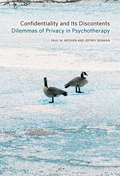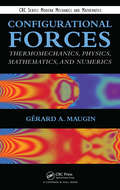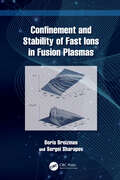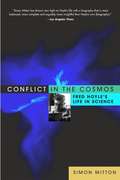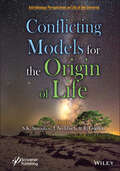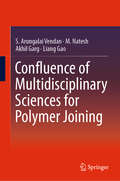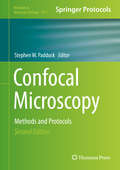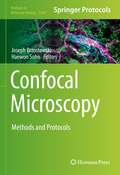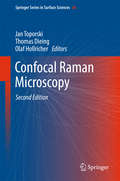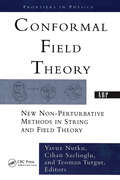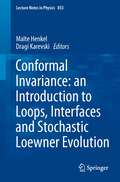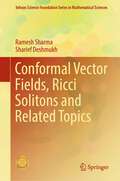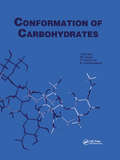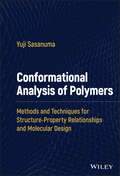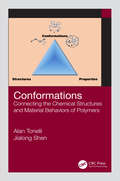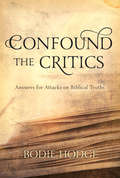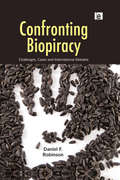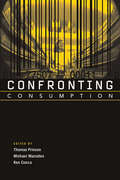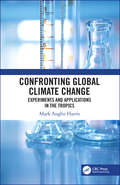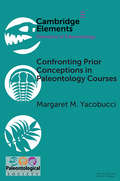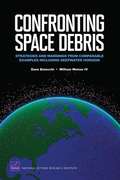- Table View
- List View
Confidentiality and Its Discontents: Dilemmas of Privacy in Psychotherapy (Psychoanalytic Interventions)
by Paul W. Mosher Jeffrey BermanFreud promised his patients absolute confidentiality, regardless of what they revealed, but privacy in psychotherapy began to erode a half-century ago. Psychotherapists now seem to serve as “double agents” with a dual and often conflicting allegiance to patient and society. Some therapists even go so far as to issue Miranda-type warnings, advising patients that what they say in therapy may be used against them.Confidentiality and Its Discontents explores the human stories arising from this loss of confidentiality in psychotherapy. Addressing different types of psychotherapy breaches, Mosher and Berman begin with the the story of novelist Philip Roth, who was horrified when he learned that his psychoanalyst had written a thinly veiled case study about him. Other breaches of privacy occur when the so-called duty to protect compels a therapist to break confidentiality by contacting the police. Every psychotherapist has heard about “Tarasoff,” but few know the details of this story of fatal attraction. Nor are most readers familiar with the Jaffee case, which established psychotherapist-patient privilege in the federal courts. Similiarly, the story of Robert Bierenbaum, a New York surgeon who was brought to justice fifteen years after he brutally murdered his wife, reveals how privileged communication became established in a state court. Meanwhile, the story of New York Chief Judge Sol Wachtler, convicted of harassing a former lover and her daughter, shows how the fear of the loss of confidentiality may prevent a person from seeking treatment, with potentially disastrous results.While affirming the importance of the psychotherapist-patient privilege, Confidentiality and Its Discontents focuses on both the inner and outer stories of the characters involved in noteworthy psychotherapy breaches and the ways in which psychiatry and the law can complement but sometimes clash with each other.
Configurational Forces: Thermomechanics, Physics, Mathematics, and Numerics (Modern Mechanics and Mathematics)
by Gerard A. MauginExploring recent developments in continuum mechanics, Configurational Forces: Thermomechanics, Physics, Mathematics, and Numerics presents the general framework for configurational forces. It also covers a range of applications in engineering and condensed matter physics. The author presents the fundamentals of accepted standard continuum mechanics
Confinement and Stability of Fast Ions in Fusion Plasmas
by Boris Breizman Sergei SharapovThis book explores the physics of fast ions and fast ion- driven instabilities. It also describes modern theory of near- critical nonlinear wave– particle systems with the particle source and wave damping. Such a theory was developed by H.L. Berk and B.N. Breizman in the mid- 1990s, and it delivered outstanding results successfully explaining the experimentally observed collective phenomena driven by energetic ions.A systematic and step-by-step analysis of resonant interactions between the waves in plasmas and various types of energetic ion populations is presented and analyzed, taking the readers on an exciting journey into the world of nonlinear physics and cutting-edge experiments performed on the world’s major magnetic fusion machines.The phenomena described in this book will be of interest for researchers studying fusion, solar plasma, space plasma, and for a broader realm of scientists working in nonlinear phenomena.Key Features: Features experimental data and the Berk-Breizman theory on nonlinear evolution of energetic particle-driven waves Describes in simple terms, the recent advances in the diagnostics of energetic particles and Alfvén waves Presents a systematic overview of extrapolating results presented in other types of plasmas (e.g., solar and space) and nonlinear systems.
Conflict In The Cosmos: Fred Hoyle's Life In Science
by Simon MittonWhile other British astronomers were specializing in narrow areas, says Mitton (astronomy, Cambridge U. ), Hoyle claimed the entire celestial realm--the universe and all its contents--as his field, and proceeded to transform the discipline during the third quarter of the 20th century. Much of the insight in the biography is gleaned from Hoyle's asso
Conflicting Models for the Origin of Life
by Richard Gordon Joseph Seckbach Stoyan K. SmoukovConflicting Models for the Origin of Life Conflicting Models for the Origin of Life provides a forum to compare and contrast the many hypotheses that have been put forward to explain the origin of life. There is a revolution brewing in the field of Origin of Life: in the process of trying to figure out how Life started, many researchers believe there is an impending second creation of life, not necessarily biological. Up-to-date understanding is needed to prepare us for the technological, and societal changes it would bring. Schrodinger’s 1944 “What is life?” included the insight of an information carrier, which inspired the discovery of the structure of DNA. In “Conflicting Models of the Origin of Life” a selection of the world’s experts are brought together to cover different aspects of the research: from progress towards synthetic life – artificial cells and sub-cellular components, to new definitions of life and the unexpected places life could (have) emerge(d). Chapters also cover fundamental questions of how memory could emerge from memoryless processes, and how we can tell if a molecule may have emerged from life. Similarly, cutting-edge research discusses plausible reactions for the emergence of life both on Earth and on exoplanets. Additional perspectives from geologists, philosophers and even roboticists thinking about the origin of life round out this volume. The text is a state-of-the-art snapshot of the latest developments on the emergence of life, to be used both in graduate classes and by citizen scientists. Audience Researchers in any area of astrobiology, as well as others interested in the origins of life, will find a modern and current review of the field and the current debates and obstacles. This book will clearly illustrate the current state-of-the-art and engage the imagination and creativity of experts across many disciplines.
Conflicts Between Biodiversity Conservation and Humans: The Case of the Chihuahua Desert and Cuatro Ciénegas (Cuatro Ciénegas Basin: An Endangered Hyperdiverse Oasis)
by Valeria Souza Luis E. Eguiarte Irene Pisanty María C. MandujanoThis book takes readers on a journey through the history of water in the Coahuila desert. It starts by describing the beauty and mysteries of the landscape, and then explores the rock art of the original desert cultures in Coahuila, offering readers a glimpse of the sacred nature of water in the desert, as well as the rituals surrounding it. Moving on to the colonial times and the post- independence development of the region, it discusses early water management, and explores how water is managed in modern times, as well as the legal complications of the law, and how these faulty laws, designed for less arid regions, have affected a highly diverse wetland, the Cuatro Ciénegas oasis. The book then examines the biological consequences of the water loss for the aquatic plants and animals in Churince – a now extinct system within Cuatro Ciénegas. Further, it addresses how even bacteria can become extinct in this hyper-diverse microbial oasis. Lastly, after this despair and sense of loss, the book provides hope, offering suggestions for how we can transform the future, from a social and educational point of view as well as through good science and changes in policy.
Conflicts of Interest In Science: How Corporate-Funded Academic Research Can Threaten Public Health
by Sheldon Krimsky30+ Years of Peer-Reviewed Studies on the Corporate Ties and Vested Interests that Influence Scientific ResearchFor over 500 years, groups and organizations with political, economic, and personal interests have successfully exercised influence on the pursuit of scientific inquiry and knowledge. History is replete with examples like the Papal authority muddying research into studies of the cosmos, but far less attention is paid today to the various corporate and special interest groups who, through funding and lobbying efforts, have been able to shape the modern academic and scientific landscape to fit their agenda.In Conflicts of Interest Within Science, author Sheldon Krimsky compiles 21 peer-reviewed, academic articles that examine the complex relationship between the individual scientists conducting research and the groups who fund them. Ultimately, Krimsky’s call to action concerns a collective movement among authors, peer reviewers, corporations and journal editors to disclose the sources of their funding. By holding scientists and the groups that fund them more accountable through increased transparency, we as a society can begin to rebuild trust in the integrity of knowledge.
Confluence of Multidisciplinary Sciences for Polymer Joining
by S. Arungalai Vendan Liang Gao Akhil Garg M. NateshThis book offers a systematic overview of polymer joining and highlights the experimental and numerical work currently being pursued to devise possible strategies to overcome the technical issues. It also covers the fundamentals of polymers, the corresponding joining processes and related technologies. A chapter on the extrapolation of finite element analysis (FEA) for forecasting the deformation and temperature distribution during polymer joining is also included. Given its breadth of coverage, the book will be of great interest to researchers, engineers and practitioners whose work involves polymers.
Confocal Microscopy: Methods and Protocols (Methods in Molecular Biology #1075)
by Stephen W. PaddockStephen Paddock and a highly skilled panel of experts lead the researcher using confocal techniques from the bench top, through the imaging process, to the journal page. They concisely describe all the key stages of confocal imaging-from tissue sampling methods, through the staining process, to the manipulation, presentation, and publication of the realized image. Written in a user-friendly, nontechnical style, the methods specifically cover most of the commonly used model organisms: worms, sea urchins, flies, plants, yeast, frogs, and zebrafish. The powerful hands-on methods collected here will help even the novice to produce first-class cover-quality confocal images.
Confocal Microscopy: Methods and Protocols (Methods in Molecular Biology #2304)
by Joseph Brzostowski Haewon SohnThis volume provides a wide range of imaging protocols that can be tailored to specific organisms or cell-types. Chapters guide readers through fixed-cell, live-cell, phenotype screening, super-resolution, intravital imaging techniques, and fluorescence life-time imaging microscopy (FLIM). Written in the highly successful Methods in Molecular Biology series format, chapters include introductions to their respective topics, lists of the necessary materials and reagents, step-by-step, readily reproducible laboratory protocols, and tips on troubleshooting and avoiding known pitfalls. Authoritative and cutting-edge, Confocal Microscopy: Methods and Protocols aims to ensure successful results in the further study of this vital field.
Confocal Raman Microscopy (Springer Series In Optical Sciences #158)
by Jan Toporski Thomas Dieing Olaf HollricherThis second edition provides a cutting-edge overview of physical, technical and scientific aspects related to the widely used analytical method of confocal Raman microscopy. The book includes expanded background information and adds insights into how confocal Raman microscopy, especially 3D Raman imaging, can be integrated with other methods to produce a variety of correlative microscopy combinations. The benefits are then demonstrated and supported by numerous examples from the fields of materials science, 2D materials, the life sciences, pharmaceutical research and development, as well as the geosciences.
Conformal Field Theory for Particle Physicists: From QFT Axioms to the Modern Conformal Bootstrap (SpringerBriefs in Physics)
by Marc GilliozThis book is a set of introductory lecture notes on Conformal Field Theory (CFT). Unlike most existing reviews on the subject, CFT is presented here from the perspective of a unitary quantum field theory in Minkowski space-time. The book starts with a non-perturbative formulation of quantum field theory (Wightman axioms) and then, gradually, focuses on the implications of scale and special conformal symmetry, all the way to the modern conformal bootstrap. This approach includes topics such as subtleties of conformal transformations in Minkowski space-time, the construction of Wightman functions and time-ordered correlators both in position- and momentum-space, unitarity bounds derived from the spectral representation, and the appearance of UV and IR divergences. In each chapter, the reader finds useful exercises to master the subject. This book is meant for graduate students in theoretical physics and for more advanced researchers working in high-energy physics who are not necessarily familiar with the concepts of conformal field theory. Prior knowledge of quantum field theory is needed to master the arguments.
Conformal Field Theory: New Non-perturbative Methods In String And Field Theory
by Yavuz NutkuQuantum field theory has been with us for over 75 years, but it is only in the last 25 that physicists and mathematicians have jointly ventured out to explore its realms beyond the reach of perturbation theory, to the great benefit of both disciplines. Conformal Field Theory consists of pedagogical lectures delivered at the Feza Gursey Institute, Istanbul, in the summer of 1998 on some of these non-perturbative approaches. The topics of these lectures are central to our emerging understanding of conformal field theory and its importance to both statistical mechanics and string theory. Lectures include Wess-Zumino-Novikov-Witten models, the WZNW model as a prototype of general CFT models, meromorphic CFT, Monstrous Moonshine and the classification of CFT, the non-perturbative dynamics of four-dimensional models, and a derivation of the hadronic structure functions from quantum chromodynamics. The book is suitable for advanced graduate students and researchers in theoretical particle or statistical physics as well as pure mathematicians.
Conformal Invariance: An Introduction To Loops, Interfaces And Stochastic Loewner Evolution (Lecture Notes in Physics #853)
by Dragi Karevski Malte HenkelConformal invariance has been a spectacularly successful tool in advancing our understanding of the two-dimensional phase transitions found in classical systems at equilibrium. This volume sharpens our picture of the applications of conformal invariance, introducing non-local observables such as loops and interfaces before explaining how they arise in specific physical contexts. It then shows how to use conformal invariance to determine their properties. Moving on to cover key conceptual developments in conformal invariance, the book devotes much of its space to stochastic Loewner evolution (SLE), detailing SLE's conceptual foundations as well as extensive numerical tests. The chapters then elucidate SLE's use in geometric phase transitions such as percolation or polymer systems, paying particular attention to surface effects. As clear and accessible as it is authoritative, this publication is as suitable for non-specialist readers and graduate students alike.
Conformal Vector Fields, Ricci Solitons and Related Topics (Infosys Science Foundation Series)
by Ramesh Sharma Sharief DeshmukhThis book provides an up-to-date introduction to the theory of manifolds, submanifolds, semi-Riemannian geometry and warped product geometry, and their applications in geometry and physics. It then explores the properties of conformal vector fields and conformal transformations, including their fixed points, essentiality and the Lichnerowicz conjecture. Later chapters focus on the study of conformal vector fields on special Riemannian and Lorentzian manifolds, with a special emphasis on general relativistic spacetimes and the evolution of conformal vector fields in terms of initial data.The book also delves into the realm of Ricci flow and Ricci solitons, starting with motivations and basic results and moving on to more advanced topics within the framework of Riemannian geometry. The main emphasis of the book is on the interplay between conformal vector fields and Ricci solitons, and their applications in contact geometry. The book highlights the fact that Nil-solitons and Sol-solitons naturally arise in the study of Ricci solitons in contact geometry. Finally, the book gives a comprehensive overview of generalized quasi-Einstein structures and Yamabe solitons and their roles in contact geometry. It would serve as a valuable resource for graduate students and researchers in mathematics and physics as well as those interested in the intersection of geometry and physics.
Conformation of Carbohydrates
by V. S. RaoThis text will give the reader a firm understanding of all aspects of carbohydrate conformation by describing and explaining the importance of interactions between carbohydrates and interactions of carbohydrates with proteins, nucleic acids or any other macromolecule., The authors have gathered a wealth of information on carbohydrate structures, different methods of conformational analysis, the role of carbohydrates as recognition molecules in biological systems and their industrial applications., Whether you are a student, teacher or a basic researcher, this text book is a ‘one-stop’ source of current information on carbohydrate conformation and the potential use of conformational properties in industry and also of their crucial role in important biological events such as cell-cell interaction, cell adhesion, cellular signaling mechanism.
Conformational Analysis of Polymers: Methods and Techniques for Structure-Property Relationships and Molecular Design
by Yuji SasanumaConformational Analysis of Polymers Comprehensive resource focusing on theoretical methods and experimental techniques to analyze physical polymer chemistry Connecting varied issues to demonstrate the impact on areas like biodegradability, environmental friendliness, structure-property relationship, and molecular design, Conformational Analysis of Polymers introduces theoretical methods and experimental techniques to analyze physical polymer chemistry. Opening with a description of fundamental concepts and then describing the conformational characteristics of various polymers, including different heteroatoms and chemical species, the text continues onto the applications of density functional theory (DFT) to polymer crystals and structure-property relationships. The book concludes by bringing these issues together to demonstrate their practical impact on different areas of the field. Various methods and techniques, including DFT, statistical mechanics, NMR, spectroscopy, and molecular orbital theory, are also covered. Written by a highly qualified author, Conformational Analysis of Polymers explores sample topics such as: Fundamentals of polymer physical chemistry: stereochemistry of polymers, models for polymeric chains, Flory-Huggins theory, and rubber elasticity Quantum chemistry for polymers: ab initio molecular orbital theory, DFT, NMR parameters, and periodic DFT of polymer crystals Statistical mechanics of polymeric chains: basic rotational isomeric state (RIS) scheme, refined RIS method, inversional-rotational isomeric state method, and probability theory for RIS scheme Experimental techniques: NMR and scattering methods Providing a timely update to the field of chain conformations of synthetic polymers and connecting fundamental theoretical approaches, experimental techniques, and case study applications; Conformational Analysis of Polymers is an essential resource for polymer chemists, physicists, and material scientists, industrial engineers who synthesize and process polymers, and academic researchers.
Conformations: Connecting the Chemical Structures and Material Behaviors of Polymers
by Alan E. Tonelli Jialong ShenAmong the materials found in Nature’s many diverse living organisms or produced by human industry, those made from polymers are dominant. In Nature, they are not only dominant, but they are, as well, uniquely necessary to life. Conformations: Connecting the Chemical Structures and Material Behaviors of Polymers explores how the detailed chemical structures of polymers can be characterized, how their microstructural-dependent conformational preferences can be evaluated, and how these conformational preferences can be connected to the behaviors and properties of their materials. The authors examine the connections between the microstructures of polymers and the rich variety of physical properties they evidence. Detailed polymer architectures, including the molecular bonding and geometries of backbone and side-chain groups, monomer stereo- and regiosequences, comonomer sequences, and branching, are explicitly considered in the analysis of the conformational characteristics of polymers. This valuable reference provides practicing materials engineers as well as polymer and materials science students a means of understanding the differences in behaviors and properties of materials made from chemically distinct polymers. This knowledge can assist the reader design polymers with chemical structures that lead to their desired material behaviors and properties.
Confound the Critics: Answers for Attacks on Biblical Truths
by Bodie HodgeCan be enjoyed by anyone from skeptics to Christians to scholars Replies to actual attacks from newspaper articles, blogs, debate boards, DVDs, and other sources Short, powerful responses to strengthen faith and develop a greater respect for God's Word! Ever been asked "Can God create a rock so heavy that He cannot lift it?" Your reply is a great opportunity to help someone receive clearer understanding of who God is and perhaps even help lead him or her to Christ. Insights like this are what make this book so unique compared to other resources. Whether you want to witness more effectively or give someone seeking truth a resource that will help, Confound the Critics is the perfect choice! And the big rock question? Make sure they are asking about the God of the Bible and remind them God isn't bound to the laws -- like gravity -- of the universe He created!
Confrontation, Strategy and War Termination: Britain's Conflict with Indonesia (Military Strategy and Operational Art)
by Christopher TuckAt the heart of this book is the problem of war termination. Britain won an almost unbroken string of tactical military victories during an undeclared war against the Republic of Indonesia in the 1960s, yet it proved difficult to translate this into strategic success. Using conflict termination theories, this book argues that British strategy during Confrontation was both exemplary and flawed, both of which need not be mutually exclusive. The British experience in Indonesia represents an illuminating case study of the difficulties associated with strategy and the successful termination of conflicts. The value of this book lies in two areas: as a contribution to the literature on British counter-insurgency operations and as a contribution to the debates on the problems of war termination in the context of strategic thought.
Confronting Biopiracy: Challenges, Cases and International Debates
by Daniel Robinson'Biopiracy' refers either to the unauthorised extraction of biological resources, such as plants with medicinal properties, and associated traditional knowledge from indigenous peoples and local communities, or to the patenting of spurious 'inventions' based on such knowledge or resources without compensation. Biopiracy cases continue to emerge in the media and public eye, yet they remain the source of considerable disagreement, confusion, controversy and grief. The aim of this book is to provide the most detailed, coherent analysis of the issue of biopiracy to date. The book synthesises the rise of the issue and increasing use of the term by activists and negotiators in the World Trade Organization (WTO) and the Convention on Biological Diversity (CBD), to form a critical understanding of the themes, implications and politics of biopiracy. Taking a case-study based approach, derived from interviews and fieldwork with researchers, government, industry, local farmers, healers and indigenous people, the author sequentially documents events that have occurred in biopiracy and bioprospecting controversies. Implications and ethical dilemmas are explored, particularly relating to work with local communities, and the power relations entailed. Detailing international debates from the WTO, CBD and other fora in an accessible manner, the book provides a unique overview of current institutional limitations and suggests ways forward. Options and solutions are suggested which are relevant for local communities, national governments, international negotiators, NGO and interest groups, researchers and industry.
Confronting Consumption (The\mit Press Ser.)
by Ken Conca Michael Maniates edited by Thomas PrincenComforting terms such as "sustainable development" and "green production" frame environmental debate by stressing technology (not green enough), economic growth (not enough in the right places), and population (too large). Concern about consumption emerges, if at all, in benign ways; as calls for green purchasing or more recycling, or for small changes in production processes. Many academics, policymakers, and journalists, in fact, accept the economists' view of consumption as nothing less than the purpose of the economy. Yet many people have a troubled, intuitive understanding that tinkering at the margins of production and purchasing will not put society on an ecologically and socially sustainable path. Confronting Consumption places consumption at the center of debate by conceptualizing "the consumption problem" and documenting diverse efforts to confront it. In Part 1, the book frames consumption as a problem of political and ecological economy, emphasizing core concepts of individualization and commoditization. Part 2 develops the idea of distancing and examines transnational chains of consumption in the context of economic globalization. Part 3 describes citizen action through local currencies, home power, voluntary simplicity, "ad-busting," and product certification. Together, the chapters propose "cautious consuming" and "better producing" as an activist and policy response to environmental problems. The book concludes that confronting consumption must become a driving focus of contemporary environmental scholarship and activism.
Confronting Global Climate Change: Experiments & Applications in the Tropics
by Mark HarrisThis book offers a solutions-based approach to climate change problems which potentially impinge on human beings within the tropics. It largely comprises research articles with supplementary applications and illustrations. <P><P>The effects of atmospheric phenomena, energy acquisition, wind power, CO2 sequestration, are linked with soils, aquatic life, reducing deforestation, rainwater harvesting and clay pot farming, climate, plant disease and food security to show that no area of life is untouched by the phenomenon of climate change. It discusses specific problem areas and provides an overview of geotechnical and sustainable solutions to lessen the impact of climate.
Confronting Prior Conceptions in Paleontology Courses (Elements of Paleontology)
by Margaret M. YacobucciPeople hold a variety of prior conceptions that impact their learning. Prior conceptions that include erroneous or incomplete understandings represent a significant barrier to durable learning, as they are often difficult to change. While researchers have documented students' prior conceptions in many areas of geoscience, little is known about prior conceptions involving paleontology. In this book, data on student prior conceptions from two introductory undergraduate paleontology courses are presented. In addition to more general misunderstandings about the nature of science, many students hold incorrect ideas about methods of historical geology, Earth history, ancient life, and evolution. Of special note are student perceptions of the limits of paleontology as scientific inquiry. By intentionally eliciting students' prior conceptions and implementing the pedagogical strategies described in other Elements in this series, lecturers can shape instruction to challenge this negative view of paleontology and improve student learning.
Confronting Space Debris
by William Welser Iv Dave BaiocchiOrbital space debris represents a growing threat to the operation of man-made systems in space. With the goal of guiding future mitigation or remediation efforts, this monograph examines nine comparable problems that share similarities with orbital debris: acid rain, U.S. commercial airline security, asbestos, chlorofluorocarbons, hazardous waste, oil spills, radon, email spam, and U.S. border control.
